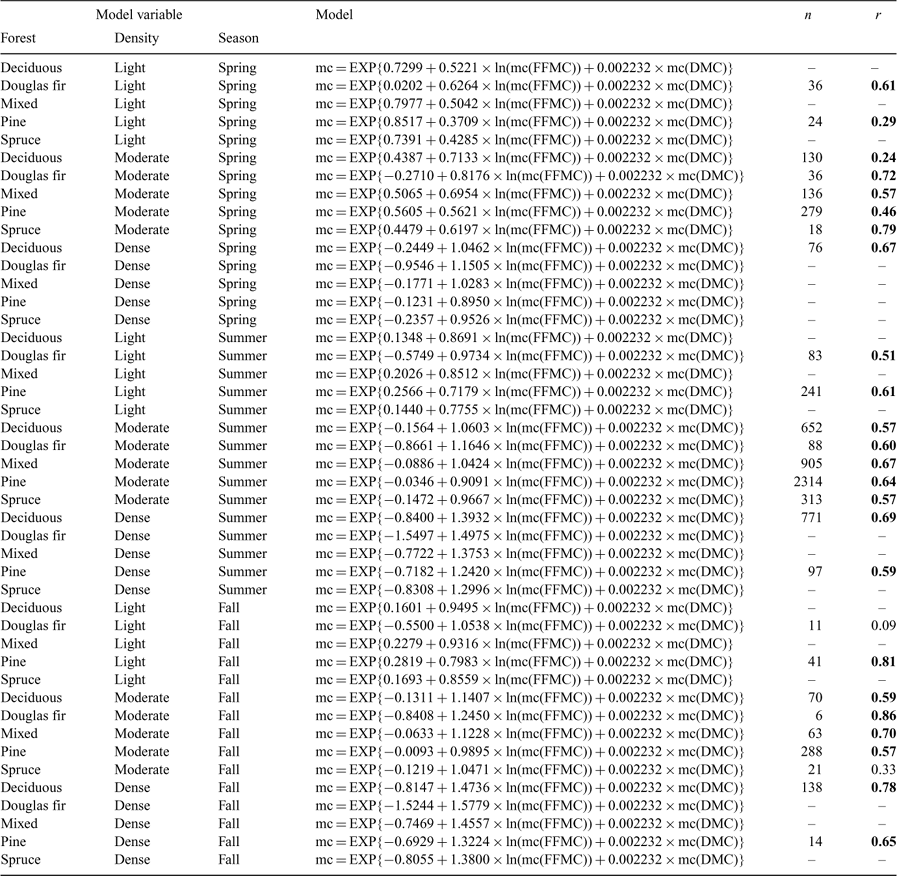Stand-specific litter moisture content calibrations for the Canadian Fine Fuel Moisture Code
B. Mike Wotton A C and Jennifer L. Beverly BA Canadian Forest Service, Natural Resources Canada, Faculty of Forestry, University of Toronto, 33 Willcocks Street, Toronto, ON M5S 3B3, Canada.
B Canadian Forest Service, Natural Resources Canada, Northern Forestry Centre, 5320 122nd Street, Edmonton, AB T6H 3S5, Canada.
C Corresponding author. Email: mike.wotton@utoronto.ca
International Journal of Wildland Fire 16(4) 463-472 https://doi.org/10.1071/WF06087
Submitted: 16 May 2006 Accepted: 23 March 2007 Published: 20 August 2007
Abstract
A large dataset of litter moisture measurements collected at several sites across Canada by the Canadian Forest Service over the period from 1939 to 1961 is analysed. The stands in which sampling was carried out were described by three main variables: forest type (pine, spruce, Douglas fir, mixedwood and deciduous), season (spring, summer and fall), and stand density (light, moderate and dense). All three variables were found to have a significant influence on the relationship between the Canadian Forest Fire Weather Index System’s Fine Fuel Moisture Code (FFMC) and surface litter moisture. Moisture in the upper duff layer was also found to have a significant influence on the relationship between FFMC and litter moisture content, with a wetter duff layer leading to moister surface conditions than would be indicated by the FFMC value. A model for litter moisture is developed, which provides a method of adjusting the standard FFMC value for the influences of forest type, stand density, season and duff moisture content.
Additional keywords: Canadian Forest Fire Danger Rating System, duff moisture.
de Groot WJ, Wardati , Wang Y (2005) Calibrating the Fine Fuel Moisture Code for grass ignition potential in Sumatra, Indonesia. International Journal of Wildland Fire 14, 161–168.
| Crossref | GoogleScholarGoogle Scholar |
Martell DL, Bevilacqua E , Stocks BJ (1989) Modelling seasonal variation in daily people-caused forest fire occurrence Canadian Journal of Forest Research 19, 1555–1563.
Vega-Garcia C, Woodard PM, Titus SJ, Adamowicz WL , Lee BS (1995) A logit model for predicting the daily occurrence of human-caused forest fires. International Journal of Wildland Fire 5, 101–112.
| Crossref | GoogleScholarGoogle Scholar |
Wotton BM , Martell DM (2005) A lightning fire occurrence model for Ontario. Canadian Journal of Forest Research 35, 1389–1401.
| Crossref | GoogleScholarGoogle Scholar |

Wotton BM, Martell DM , Logan KA (2003) Climate change and people-caused forest fire occurrence in Ontario. Climatic Change 60, 275–295.
| Crossref | GoogleScholarGoogle Scholar |

1 A more detailed report describing the test fire procedures and experimental sites is being prepared: J. L. Beverly and B. M. Wotton: The Canadian small-scale test database: historical overview and data documentation. Canadian Forest Service Northern Forestry Centre, Information Report.
2 Data (unpublished) from fire tower observations (1999–2004) of leaf flush indicate that leaf flush in aspen occurs very close to the end of May in this area on average. Although this is of course an approximation, we do not feel it has influenced the results greatly.
Appendix 1

|


